|
|
|
Sort Order |
|
|
|
Items / Page
|
|
|
|
|
|
|
| Srl | Item |
| 1 |
ID:
124784
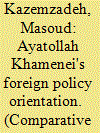

|
|
|
|
|
| Publication |
2013.
|
| Summary/Abstract |
This article analyzes the beliefs and patterns of behavior of Iran's Supreme Leader Ayatollah Ali Khamenei in regards to the nature of politics, political conflicts, and the role of agency in shaping events, strategy, and tactics. To do so, it discusses Khamenei's personal background, ideological formation, personality, and foreign policy statements.
|
|
|
|
|
|
|
|
|
|
|
|
|
|
|
|
| 2 |
ID:
129104
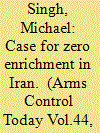

|
|
|
|
|
| Publication |
2014.
|
| Summary/Abstract |
In the debate over sanctions on Iran-their role in bringing Tehran to the negotiating table and their proper place in U.S. diplomatic strategy in the future-scant attention has been paid to a major shift in the negotiating position of the P5+1, the group of six countries (China, France, Germany, Russia, the United Kingdom, and the United States) that is negotiating with Tehran over the Iranian nuclear program. No longer is the P5+1 demanding that Iran halt uranium enrichment. Indeed, in the November 24 first-step nuclear accord, the Joint Plan of Action,[1] the P5+1 all but concedes that Iran will be permitted to enrich in perpetuity. In separate comments that have quickly become conventional wisdom among Iran analysts, U.S. negotiators now characterize their previous position that Iran should halt enrichment as "maximalist."[2] Although undoubtedly expedient, this shift away from a zero-enrichment negotiating position is misguided and unnecessary.[3] The U.S. shift away from zero enrichment to limited enrichment represents a significant diplomatic victory for Iran. For the last decade, the position of the EU-3 (France, Germany, and the UK) and then the P5+1 had been that Iran must "suspend all enrichment-related and reprocessing activities, including research and development." This position was enshrined as an Iranian obligation in a series of UN Security Council resolutions.[4] Iran, however, asserted a "right to enrich" and refused to halt enrichment after resuming it when nuclear talks with the European Union broke down in 2005. This difference formed the core of the confrontation that subsequently developed between Iran and the allies.
|
|
|
|
|
|
|
|
|
|
|
|
|
|
|
|
| 3 |
ID:
125386
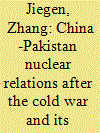

|
|
|
|
|
| Publication |
2013.
|
| Summary/Abstract |
Though China-Pakistan relations have been viewed by both countries as 'all weather, time-tested strategic cooperative partnership all along, there are comparative few studies relating to this bilateral relations in the research field of Chinese foreign affairs in China. Considering the extraordinary importance of Pakistan in the integral structure of China's foreign relations, this kind of phenomenon in the academy of China is quite abnormal. The year 2011 marked the sixtieth anniversary of the establishment of the diplomatic relations between China and Pakistan. There are a series of papers relating to China-Pakistan relations published to celebrate this occasion. However, these papers are mainly macro-level studies and focus on the strategic aspects of the bilateral relations, but lacking in in-depth studies for detailed aspects and specific issues in China-Pakistan relations.
|
|
|
|
|
|
|
|
|
|
|
|
|
|
|
|
| 4 |
ID:
129103
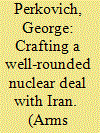

|
|
|
|
|
| Publication |
2014.
|
| Summary/Abstract |
A final nuclear deal with Iran should meet the underlying objective of the relevant UN Security Council resolutions since 2006: "the establishment of international confidence in the exclusively peaceful nature of Iran's nuclear programme."A final agreement could be codified and endorsed through a new resolution, which need not include all of the specific instrumental elements of past resolutions-for example, suspension of all uranium enrichment-if the council determines that the overall objective has been met. As the resolutions acknowledge, to be durable, such an agreement also must satisfy Iran's interest in having a purely peaceful nuclear program free from sanctions. The devilish challenge will be in the details. History will inform each party's requirements. The six-country group that has been negotiating with Iran, the so-called P5+1 (China, France, Germany, Russia, the United Kingdom, and the United States), will remember that Iran secretly had, at least until 2003, what appeared to be a dedicated, multifaceted program to acquire capabilities to produce nuclear weapons. Iran still has not cooperated fully with the International Atomic Energy Agency (IAEA) to clarify these activities and continues to expand sensitive fuel-cycle capabilities beyond any plausible civilian requirement. Iranian leaders, for their part, remember numerous episodes that reflect a U.S. determination to hasten an end to their regime.
|
|
|
|
|
|
|
|
|
|
|
|
|
|
|
|
| 5 |
ID:
134084
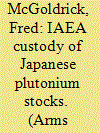

|
|
|
|
|
| Publication |
2014.
|
| Summary/Abstract |
Even before the 2011 Fukushima nuclear disaster shut down all 48 Japanese nuclear reactors, Japan's plan to reprocess its spent nuclear fuel and use the recovered plutonium and uranium as mixed-oxide (MOX) fuel in its nuclear power plants suffered from significant delays.
|
|
|
|
|
|
|
|
|
|
|
|
|
|
|
|
| 6 |
ID:
128082
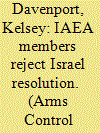

|
|
|
|
|
| Publication |
2013.
|
| Summary/Abstract |
A resolution critical of Israel's nuclear program, revived after a two-year hiatus, failed to pass the General Conference of the International Atomic Energy Agency (IAEA) last month. The nonbinding resolution, sponsored by a group of 18 Arab states, would have called on Israel to join the nuclear Nonproliferation Treaty (NPT) as a non-nuclear-weapon state and put all of its nuclear sites under comprehensive IAEA safeguards. The measure, referred to as "Israeli Nuclear Capabilities" on the IAEA agenda, failed by a vote of 43-51 on Sept. 20, the last day of the conference.
|
|
|
|
|
|
|
|
|
|
|
|
|
|
|
|
| 7 |
ID:
127071
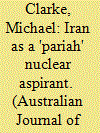

|
|
|
|
|
| Publication |
2013.
|
| Summary/Abstract |
This article demonstrates that Iran conforms to Richard K. Betts' model of a 'pariah' nuclear aspirant, as its nuclear program is driven by a potent combination of security, normative and domestic political motivations. The regime's commitment to its nuclear program is influenced by Iran's long-standing sense of vulnerability to both regional and international adversaries, and an enduring sense of national humiliation at the hands of foreign powers, in parallel with a powerful belief in the superiority of Persian civilisation. This has resulted in the development of a narrative of 'hyper-independence' in Iran's foreign policy that simultaneously rejects political, cultural or economic dependence and emphasises 'self-reliance'. The presumed security benefits that a nuclear weapons option provides are seen as ensuring Iranian 'self-reliance' and 'independence'. This suggests that current strategies that focus exclusively on Iran's security motivations or on a heightened regime of sanctions are fundamentally flawed, as they fail to recognise the mutually reinforcing dynamic between Iran's security and normative/status-derived nuclear motivations
|
|
|
|
|
|
|
|
|
|
|
|
|
|
|
|
| 8 |
ID:
131601
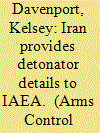

|
|
|
|
|
| Publication |
2014.
|
| Summary/Abstract |
Iran provided the International Atomic Energy Agency (IAEA) with information about the country's past development of a detonator that could be used as a trigger in nuclear weapons, the agency said last month in a quarterly report. The report also found that Iran is complying with the measures outlined in an interim agreement it reached Nov. 24 with six world powers that restricts its nuclear activities in exchange for sanctions relief. The "technical exchange" with the IAEA on the issues related to possible nuclear weapons development was the first since 2008, the May 23 report said.
|
|
|
|
|
|
|
|
|
|
|
|
|
|
|
|
| 9 |
ID:
129109
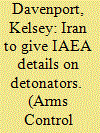

|
|
|
|
|
| Publication |
2014.
|
| Summary/Abstract |
Iran will provide the International Atomic Energy Agency (IAEA) with information about its past development of a detonator that could be used to as a trigger in nuclear weapons, according to an agreement reached by the two sides last month. In a Feb. 9 joint statement, Iran and the IAEA described the two days of talks in Tehran as "constructive" and announced seven actions for Iran to take by May 15 to further the agency's investigations into its unresolved concerns about Iran's current nuclear program and past actions. One of the actions requires Tehran to provide the IAEA with information on exploding bridge wire detonators, which can be used to trigger nuclear weapons. They can also be used in civilian applications, including drilling for oil and gas, and for conventional military explosives.
|
|
|
|
|
|
|
|
|
|
|
|
|
|
|
|
| 10 |
ID:
127860
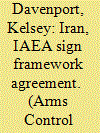

|
|
|
|
|
| Publication |
2013.
|
| Summary/Abstract |
Iran and the International Atomic Energy Agency (IAEA) last month signed a framework agreement outlining future cooperation on the agency's investigations into Tehran's past activities that are suspected of having been part of an effort to develop nuclear weapons. The agreement included six initial actions for Iran to take by mid-February 2014 that will provide the IAEA with access to two nuclear sites and information on Iran's planned nuclear power plants and research reactors. IAEA Director-General Yukiya Amano and Ali Akbar Salehi, head of the Atomic Energy Organization of Iran, signed the agreement in Tehran on Nov. 11. In a statement following the signing, Amano said that "subsequent steps" under the framework would address issues that the six actions do not cover.
|
|
|
|
|
|
|
|
|
|
|
|
|
|
|
|
| 11 |
ID:
127859
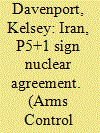

|
|
|
|
|
| Publication |
2013.
|
| Summary/Abstract |
Iran and six world powers last month achieved an apparent breakthrough in negotiations over Tehran's controversial nuclear program when the parties reached a first-phase agreement on a six-month deal that will halt Iran's most sensitive nuclear activities and increase international monitoring of its nuclear program in exchange for some relief from sanctions that have hurt Iran's economy.
|
|
|
|
|
|
|
|
|
|
|
|
|
|
|
|
| 12 |
ID:
131598
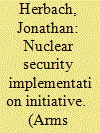

|
|
|
|
|
| Publication |
2014.
|
| Summary/Abstract |
The nuclear security summit that took place in The Hague in March was likely the penultimate gathering in the process that President Barack Obama started in 2009. As with the previous summits, in 2010 and 2012, participating states made a number of pledges to reduce the amounts of nuclear material within their borders and to better secure remaining nuclear and other radioactive materials. In one of the major developments of this year's summit, several states went further than before in taking concrete steps aimed at enhancing the legal and regulatory framework with a view to ensuring sustainability of nuclear security efforts. This was manifested most directly in the initiative on strengthening nuclear security implementation, announced by the Netherlands, South Korea, and the United States and joined by two-thirds of the participating states.[1] The initiative was one of the most publicized outcomes of the meeting and arguably the most significant.[2] It looks toward laying the groundwork for a more robust international system based on national commitments to the application of international principles and guidelines[3] and to continuous improvement of nuclear security regimes through peer reviews and other methods. The question is how this initiative will actually be put into practice. The commitment to conduct self-assessments, host peer reviews periodically, and act on recommendations stemming from such reviews is fairly clearly formulated, whereas some of the language is quite general, referring to "meet[ing] the intent of" international nuclear security guidelines and "subscrib[ing] to" a set of fundamental principles developed under the auspices of the International Atomic Energy Agency (IAEA). Therefore, although the initiative holds potentially far-reaching consequences for the future strength of the nuclear security regime, such consequences will largely depend on how subscribing states choose to interpret the commitments. If the initiative is to have a strong impact, states will need to take the view that it lays a foundation on which they can build through further actions rather than being a final goal in itself.
|
|
|
|
|
|
|
|
|
|
|
|
|
|
|
|
| 13 |
ID:
134083
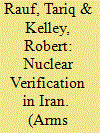

|
|
|
|
|
| Publication |
2014.
|
| Summary/Abstract |
For nearly a year, negotiations on Iran's nuclear program have been underway between Iran and the EU3+3 (China, France, Germany, Russia, the United Kingdom, and the United States).[1] The two sides in the negotiations, which the European Union has facilitated, are seeking a "mutually-agreed long-term comprehensive solution that would ensure Iran's nuclear programme will be exclusively peaceful."[2]
In November 2013, the sides agreed to an arrangement known as the Joint Plan of Action, under which Iran has taken substantial steps to address proliferation concerns about its nuclear activities. In particular, under International Atomic Energy Agency (IAEA) safeguards supplemented by additional IAEA monitoring and verification pursuant to the Joint Plan of Action, Iran has halted the production of uranium enriched to 20 percent uranium-235 and down-blended half its entire stock of that material to below 5 percent U-235 while converting the rest to uranium oxide, which cannot be immediately used for enrichment. In addition, Iran has capped the production of 5 percent-enriched uranium and accepted daily IAEA inspector access at its uranium-enrichment facilities at Natanz and Fordow and monthly access at the under-construction Arak heavy-water reactor, among other measures.[3]
|
|
|
|
|
|
|
|
|
|
|
|
|
|
|
|
| 14 |
ID:
129669
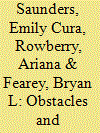

|
|
|
|
|
| Publication |
2014.
|
| Summary/Abstract |
Tactical nuclear weapons have emerged as an unavoidable issue for future nuclear weapons negotiations between Russia and the United States. This article discusses challenges and opportunities regarding a tactical nuclear weapons treaty. It begins with an overview of precedents from the 1987 Intermediate Nuclear Forces Treaty and the 1991 Presidential Nuclear Initiatives. These and subsequent experiences show three major obstacles that must be overcome to permit bi-lateral agreement on tactical nuclear weapons: definitional issues over differentiating tactical from strategic nuclear weapons; negotiation challenges including the asymmetries between American and Russian tactical arsenals and non-nuclear capabilities such as ballistic missile defence and conventional prompt global strike; and verification questions over whether and how warhead status can be verified without disclosing sensitive information. This analysis examines whether the International Atomic Energy Agency could have a role in verification to help facilitate agreement. Lastly, this article offers various confidence building measures, emphasizing areas where the two countries could cooperate. While the obstacles are serious, there are opportunities for achieving consensus on some contentious issues.
|
|
|
|
|
|
|
|
|
|
|
|
|
|
|
|
| 15 |
ID:
134051
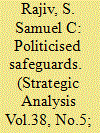

|
|
|
|
|
| Publication |
2014.
|
| Summary/Abstract |
This article examines Iranian contentions on three issue areas that exemplify the politicised nature of its interactions with the International Atomic Energy Agency (IAEA). These include access to military facilities, information credibility and the 'nuclear activism' of US-based non-governmental organisations (NGOs). Three drivers account for the emergence of such contentions: (1) multilateral and unilateral sanctions; (2) extended lack of progress at multilateral negotiating forums like the P5+1 and the E3/EU; and (3) organisational dynamics primarily related to the deterioration in Iran's interactions with the IAEA in the aftermath of the election of Yukiya Amano as the IAEA Director General (DG). Changes in dynamics in one or more of these factors, on the back of changes in domestic political leaderships (primarily in the US and Iran) and consequent modifications in their respective policy positions, have led to mutually agreeable outcomes like the November 2013 Joint Plan of Action (JPOA). In the context of 'politicised safeguards' losing some of their edge in the aftermath of the JPOA, the article closes by briefly examining the prospects of the IAEA drawing a 'broader [safeguards] conclusion' for Iran amidst the significant challenges that still need to be addressed.
|
|
|
|
|
|
|
|
|
|
|
|
|
|
|
|
| 16 |
ID:
127856


|
|
|
|
|
| Publication |
2013.
|
| Summary/Abstract |
As the Dutch "sherpa" for the nuclear security summit scheduled to take place March 24-25 in The Hague, Piet de Klerk is the host country's lead coordinator and negotiator for the event. Before taking that position in mid-2012, he was the chairman of the Nuclear Suppliers Group. From 2011 to 2013, he was the Dutch ambassador to Jordan. In previous postings with the Dutch Foreign Ministry and the International Atomic Energy Agency (IAEA), he has held numerous positions dealing with nuclear arms control and nonproliferation.
|
|
|
|
|
|
|
|
|
|
|
|
|
|
|
|
| 17 |
ID:
133993
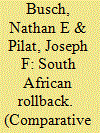

|
|
|
|
|
| Publication |
2014.
|
| Summary/Abstract |
As the only country in history to have created, then voluntarily renounced, a nuclear arsenal, South Africa is often referenced as a potential model for nuclear disarmament. However, this article argues that there are sharp limitations on the extent to which the South African case can be applied as a model for other countries to follow. Because South Africa unilaterally dismantled its program and only brought in inspectors from the International Atomic Energy Agency (IAEA) and key member states after the dismantlement was complete, information vital to the verification process was lost to the international community. As a model of a cooperative verification, South Africa thus highlights both the difficulties that monitoring and verification regimes will encounter, as well as the opportunities that they afford.
|
|
|
|
|
|
|
|
|
|
|
|
|
|
|
|
| 18 |
ID:
130339
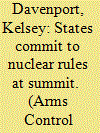

|
|
|
|
|
| Publication |
2014.
|
| Summary/Abstract |
Thirty-five countries last month launched an initiative that they said bolsters their commitment to implementing existing international guidelines on nuclear security, in part by incorporating the "fundamentals" of the voluntary guidelines into binding national rules The initiative was announced at the March 24-25 nuclear security summit in The Hague, the third in the series of biennial meetings. In a March 25 press conference in The Hague announcing the initiative, U.S. Energy Secretary Ernest Moniz said the initiative is the "closest thing we have to international standards for nuclear security.
|
|
|
|
|
|
|
|
|
|
|
|
|
|
|
|
| 19 |
ID:
128262


|
|
|
|
|
| Publication |
2013.
|
| Summary/Abstract |
In the two and a half years since the March 11, 2011 earthquake and tsunami disaster followed by the nuclear accident at Fukushima power plant, the Japanese government has been investigating the cause as well as assessing the responses taken as disaster management. This article analyzes the measures taken and makes recommendations for clarifying responsibility to improve efficiency and effectiveness in mitigating damage after a large-scale disaster.
It is highly regrettable that, although the result of a massive earthquake and tsunami of an unprecedented scale, the accident at the Fukushima nuclear power plant developed into a core meltdown, releasing nuclear material and forcing many residents to evacuate their homes. The crisis has undermined public faith in the safety of nuclear power generation. The Japanese government and Tokyo Electric Power Company (TEPCO) must conduct a thorough investigation into the cause, and review and assess the validity of the existing emergency response procedures as well as the relevancy of the measures actually taken for resident evacuation and radiation damage control in collaboration with the International Atomic Energy Agency (IAEA) and other international and government agencies. Sharing the results internationally will help improve nuclear safety around the world.
The biggest problem surrounding the accident was the intricate chain of command and control for disaster management. Since the authority and responsibility of the agencies concerned were extremely ambiguous, the government was unable to make good use of the systems and institutions designed to cope with nuclear disasters. To make matters worse, newly created posts and entities complicated the problem.
|
|
|
|
|
|
|
|
|
|
|
|
|
|
|
|
| 20 |
ID:
130326
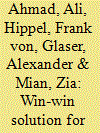

|
|
|
|
|
| Publication |
2014.
|
| Summary/Abstract |
In November 2013, Iran and the P5+1 group of countries (China, France, Germany, Russia, the United Kingdom, and the United States) agreed on a six-month Joint Plan of Action to enable negotiations on a final settlement to contain the proliferation risks from Iran's nuclear program. This interim agreement freezes Iran's enrichment capacity, thereby preventing a further shortening of the time Iran would require to produce weapons quantities of highly enriched uranium (HEU) if it wished.1 This enrichment capacity has expanded greatly over the years since it first came to international attention in 2002. Iran and the P5+1 also have agreed on the need to constrain Iran's option to produce plutonium for weapons using the reactor that is under construction near the city of Arak and that will be under International Atomic Energy Agency (IAEA) safeguards. Under the Joint Plan of Action, Iran has agreed to freeze the Arak reactor project for six months.2 It also has committed not to separate plutonium from spent nuclear fuel or construct a facility capable of doing so. These are important interim commitments. According to Ali Akbar Salehi, the head of the Atomic Energy Organization of Iran, the Arak reactor is intended for radioisotope production and testing of nuclear fuel and materials. In response to the P5+1 proposal that Iran scrap the Arak reactor project, Salehi stated that "we see no point stopping the work on this reactor." He has acknowledged, however, the international community's concerns about the Arak reactor and offered the possibility of design changes "in order to produce less plutonium in this reactor and in this way allay the worries and mitigate the concerns.
|
|
|
|
|
|
|
|
|
|
|
|
|
|
|
|
|
|
|
|
|